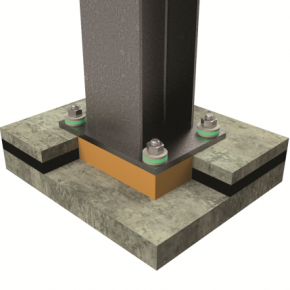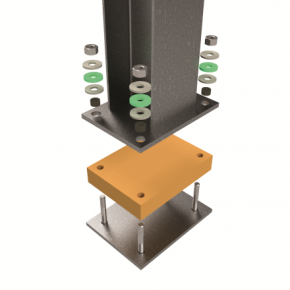
ACE Fabreeka UK Introduces a new thermal break material for the construction sector
Reducing thermal bridging in building envelope connections is an ongoing mission, as architects and engineers strive to design and construct energy efficient buildings; to alleviate this problem, ACE Fabreeka UK has introduced Fabreeka-TIM® RF into its family of Fabreeka-TIM® thermal bridging products for the building and construction sectors.
Thermal bridging occurs when conductive materials provide a conduit for energy to transfer across a thermal barrier creating an energy loss and potential for condensation.
Fabreeka-TIM® RF is a high density, closed cell rigid polyurethane foam, used as an effective thermal break for a variety of applications, such as column base thermal isolation for roof equipment, cold storage facilities or to reduce thermal bridging between a roof and outdoor space.
It also provides column base thermal insulation and is manufactured in several densities to support a range of load conditions.

The unique properties of Fabreeka-TIM® RF make it impermeable by any type of liquid, including water and most solvents, thus suited for moisture, severe weather conditions or harsh environments.
With additional qualities as a structural thermal isolation block, it is resistant to mechanical stress and has exceptional insulating qualities, which makes it a valuable asset to reduce thermal bridging in non-moment building envelope connections and cold storage applications.
Three densities are available to meet load conditions and the material can be custom waterjet cut to a particular specification, including anchor bolt holes. Products therefore arrive on site, ready to use.
For optimal thermal break performance, the area around the fastener hardware should also be taken into consideration by using thermal break washers and bushings made from Fabreeka® material.
Applications include
– Structural column bases, especially vital in cold storage/freezer facilities.
– Tank isolation block – reduces condensation by thermally isolating cooling equipment from its supporting structure.
– Roof equipment and dunnage post support block – supports HVAC, fans, davits, anchors and other heavy equipment on building roofs while preventing heat transfer to the building interior.
– Foundation connections, i.e. slab to foundation, foundation to wall.
Latest news

28th March 2025
Ideal Heating Commercial announces 10-year warranty on Evomax 2 boiler
Evomax 2, the UK’s number one selling commercial wall-mounted boiler from Ideal Heating Commercial, is now available with a 10-year warranty.
Posted in Articles, Building Industry News, Building Products & Structures, Building Regulations & Accreditations, Building Services, Facility Management & Building Services, Heating Systems, Controls and Management, Heating, Ventilation and Air Conditioning - HVAC, Innovations & New Products, Pipes, Pipes & Fittings, Plumbing, Retrofit & Renovation, Sustainability & Energy Efficiency, Videos
28th March 2025
FLIR Si1-LD Acoustic Imaging Camera for Compressed Air Leak Detection
FLIR, a Teledyne Technologies company, introduces the Si1-LD, an industrial acoustic imaging camera that brings faster and more accurate compressed air leak detection to those operating on a modest condition monitoring budget.
Posted in Acoustics, Noise & Vibration Control, Articles, Building Industry News, Building Products & Structures, Building Services, Facility Management & Building Services, Information Technology, Innovations & New Products, Retrofit & Renovation, Sustainability & Energy Efficiency, Thermal Imaging and Monitors
28th March 2025
LIFTEX 2025 Seminar programme announced
Registration has opened for LIFTEX 2025. Now in its 37th year, LIFTEX 2025 is the UK’s only dedicated exhibition for the lift, escalator and access industry and takes place only once every three years.
Posted in Access Control & Door Entry Systems, Accessibility, Articles, Building Industry Events, Building Industry News, Building Products & Structures, Building Regulations & Accreditations, Building Services, Exhibitions and Conferences, Facility Management & Building Services, Health & Safety, Retrofit & Renovation, Security and Fire Protection, Seminars
28th March 2025
MCRMA welcomes ArcelorMittal UK to membership
A UK division of the global steelmaking business ArcelorMittal has become the latest new member of the MCRMA, the industry association representing the metal building envelope sector.
Posted in Articles, Building Associations & Institutes, Building Industry News, Building Products & Structures, Building Systems, Cladding, Facades, Posts, Restoration & Refurbishment, Retrofit & Renovation, Roofs, Steel and Structural Frames, Walls
 Sign up:
Sign up: